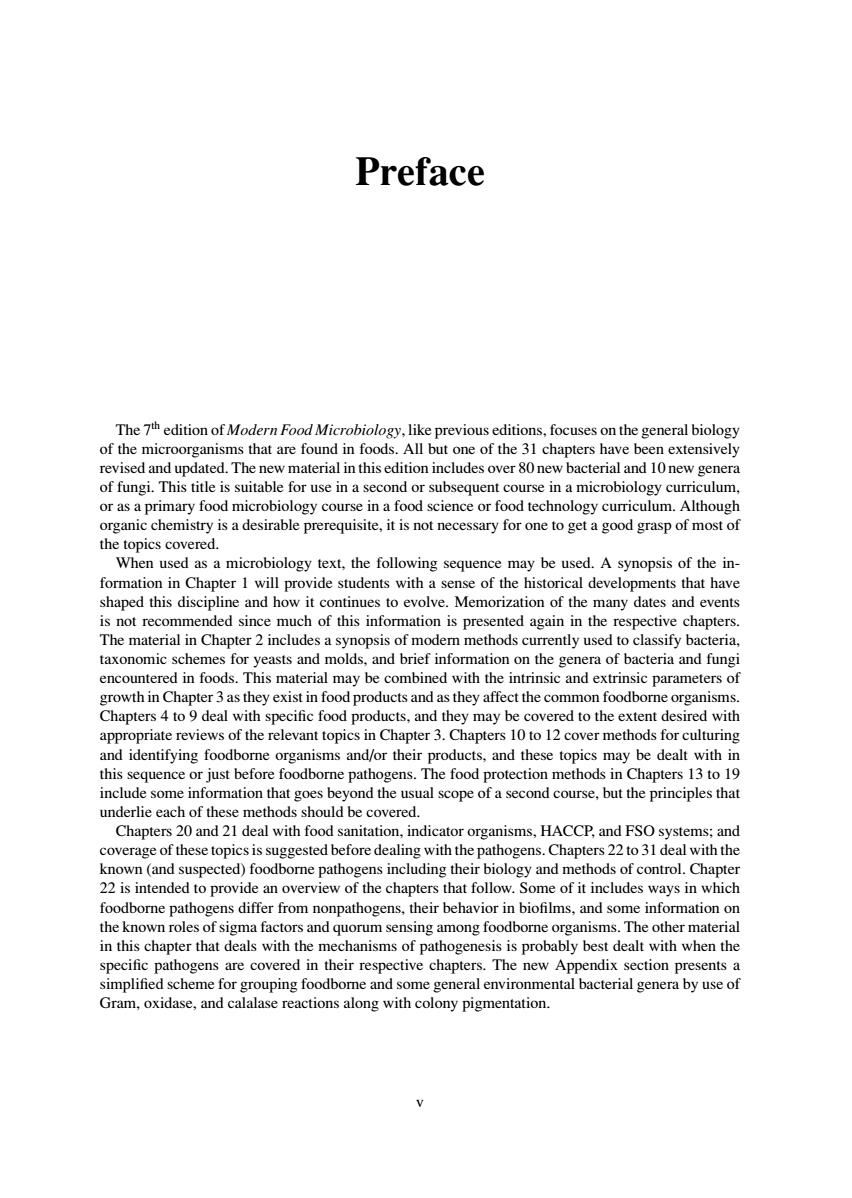正在加载图片...

Preface s that are fo revised and updated.The new material in this edition includes over 80new bacterial and 10new genera of fungi.This title is suitable for use in a second or subsequent course in a microbiology curriculum. or as a primary food microbiology course in a food science or food technology curriculum.Although organic chemistry is a desirable prerequisite,it is not necessary for one to get a good grasp of most of the topics covered. microbiology text,the following sequenc of the this dis provide of the have is not rece mended since much of this information is presented again in the tive chanter The material in Chapter 2 includes a synopsis of modem methods currently used to classify bacteria. taxonomic schemes for yeasts and molds,and brief information on the genera of bacteria and fungi encountered in foods.This material may be combined with the intrinsic and extrinsic parameters of er3a ey exis ect the common foodb ey may ata vered to the e v be dealt with in this sequence or just before oe.The food protec on m nods in Chapters 13 to 19 include some information that goes beyond the usual scope of a second course.but the principles that underlie each of these methods should be covered. Chapters 20 and 21 deal with food sanitation.indicator organisms.HACCP,and FSO systems;and ing with the pathogens.Chapter 3deal with the y and contro of it ways in the known roles a factors and au ganisms.The other ma in this chapter that deals with the mechanisms of pathogenesis is probably best dealt with when the specific pathogens are covered in their respective chapters.The new Appendix section presents a simplified scheme for grouping foodbome and some general environmental bacterial genera by use of Gram,oxidase,and calalase reactions along with colony pigmentation.Preface The 7th edition of Modern Food Microbiology, like previous editions, focuses on the general biology of the microorganisms that are found in foods. All but one of the 31 chapters have been extensively revised and updated. The new material in this edition includes over 80 new bacterial and 10 new genera of fungi. This title is suitable for use in a second or subsequent course in a microbiology curriculum, or as a primary food microbiology course in a food science or food technology curriculum. Although organic chemistry is a desirable prerequisite, it is not necessary for one to get a good grasp of most of the topics covered. When used as a microbiology text, the following sequence may be used. A synopsis of the information in Chapter 1 will provide students with a sense of the historical developments that have shaped this discipline and how it continues to evolve. Memorization of the many dates and events is not recommended since much of this information is presented again in the respective chapters. The material in Chapter 2 includes a synopsis of modern methods currently used to classify bacteria, taxonomic schemes for yeasts and molds, and brief information on the genera of bacteria and fungi encountered in foods. This material may be combined with the intrinsic and extrinsic parameters of growth in Chapter 3 as they exist in food products and as they affect the common foodborne organisms. Chapters 4 to 9 deal with specific food products, and they may be covered to the extent desired with appropriate reviews of the relevant topics in Chapter 3. Chapters 10 to 12 cover methods for culturing and identifying foodborne organisms and/or their products, and these topics may be dealt with in this sequence or just before foodborne pathogens. The food protection methods in Chapters 13 to 19 include some information that goes beyond the usual scope of a second course, but the principles that underlie each of these methods should be covered. Chapters 20 and 21 deal with food sanitation, indicator organisms, HACCP, and FSO systems; and coverage of these topics is suggested before dealing with the pathogens. Chapters 22 to 31 deal with the known (and suspected) foodborne pathogens including their biology and methods of control. Chapter 22 is intended to provide an overview of the chapters that follow. Some of it includes ways in which foodborne pathogens differ from nonpathogens, their behavior in biofilms, and some information on the known roles of sigma factors and quorum sensing among foodborne organisms. The other material in this chapter that deals with the mechanisms of pathogenesis is probably best dealt with when the specific pathogens are covered in their respective chapters. The new Appendix section presents a simplified scheme for grouping foodborne and some general environmental bacterial genera by use of Gram, oxidase, and calalase reactions along with colony pigmentation. v